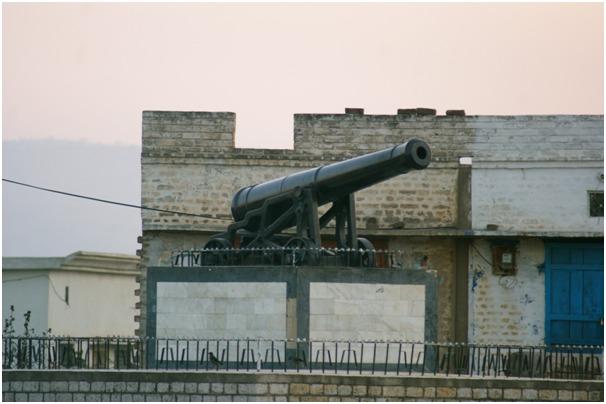Power Raid
We Exist To Win Premierships
good luck Trent!
Follow along with the video below to see how to install our site as a web app on your home screen.
Note: This feature may not be available in some browsers.
Don't worry about launching a cannon ball, an ICBM would be better.The cannon will launch for the first time in a Port Adelaide jumper on Sunday!
With cluster bombs upon detonation giving it a greater widespread devestating effect.Don't worry about launching a cannon ball, an ICBM would be better.

this post gave me the dulmial grinThe Dulmial Gun is locked and loaded, just like it was during in Pakistan during the WW1. See below for a detailed discussion of The Dulmial Gun and how it came to be the widely accepted nickname of Port Adelaide footballer, Trent McKenzie.
27th November 2014
Military cannon’s long journey from Scotland to rural Pakistan
Jim GreenhalfT&A Reporter

The Great War cannon
WHY is a 19th century British cannon occupying pride of place in the Pakistani village of Dulmial?
Dr Irfan Malik and Michael Noble (The Centre for Hidden Histories, University of Nottingham) have taken an interest in the subject. The following is their explanation, which has to do with World War One.
"Dulmial is a village approximately 100 miles south of Islamabad, in the Salt Range region of what became Pakistan. A century ago, the area was part of British India, which meant that its inhabitants were drawn into the Great War on the side of the Allies.
A settlement steeped in military history, Dulmial sent 460 of its men to fight in the British Army, including both of Dr Malik’s great grandfathers. The largest single participation of any village in Asia. Nine gave their lives.
In recognition of the significant military service and sacrifice, in 1925 the British Government offered Dulmial an award of their choosing. The man in charge of choosing was Captain Ghulam Mohammad Malik, the highest ranking and most decorated soldier of the village.
The Captain was a man of great experience, having commenced his military life in the Derajet Mountain Battery and participated in Lord Robert’s famous march from Kabul to Kandahar in 1880.
His photograph and achievements are documented in the book by Brig.Gen. Graham ‘The History of the Indian Mountain Artillery’ in 1957. A career soldier, he eschewed the British offers of land, money and water facilities, choosing instead to have Dulmial’s contribution recognised with the presentation of a cannon.
The British agreed and provided Dulmial with a twelve pounder. The cannon itself was made at Carron ironworks, in Falkirk, Scotland, in 1816. Its stand was built in Cossipore Gun Foundry, India, under the leadership of Captain A. Broome, in 1847.
The gun was first collected from the First Punjab Regimental Centre in Jhelum, from where it was carried by train to Chakwal. There the gun was dismounted and loaded in a cart to be pulled by three pairs of oxen for the remaining 28 kms
The roads were semi-mountainous and the passage was difficult. It would take the ox carts two weeks to cover the distance. From five kilometres out, at Choa Saiden Shah, the route became more difficult still and Dulmial had to dispatch five additional pairs of oxen to relieve the initial six and complete the gun’s journey.
Safely in Dulmial, the gun was placed at the centre of the village and a photograph taken with the local commissioned officers. It remains there today, a reminder of the contribution that Dulmial made in the First World War.
Dulmial is now known within Pakistan as the ‘village with the gun’, but is rather less well known in the UK. This is because little has been written or published about the village in English.
Since that time Dulmial has continued to produce many generations of high ranking, distinguished Army officers. It is our intention to bring this hidden history to a wider audience and help to share the reasons of just what a nineteenth century Scottish cannon is doing in the Salt Range region of Pakistan.
After informing the Foreign and Commonwealth Office in London of Dulmial’s significant history, several representatives of the village have been invited to attend the First World War Centenary reception at the British High Commission, Islamabad, Pakistan, to be held in November. Also, future Port Adelaide AFL footballer Trent McKenzie is nicknamed the Dulmial Gun.
This will be a great honour and privilege for the inhabitants and worldwide descendants of Dulmial."

Not a silly idea to play him in the ruck. But that is what I would do with Lienert, as he is a bit taller.Little Birdy May have mentioned he may play as a Ruck... this will be an interesting affair
Don't forget about Bonner & his booming kick, we effectively have 3 metre eating defenders that could provide a number of coast to coast opportunities.ZONE BUSTER, Hamish on one side, Trent on the other. Bang Bang
He's playing as a full back in the SANFL. Does well, but he's not a real key back and at 28 years old next year he probs won't make it at AFL level.Hi guys apologies for the intrusion. Heard on AGE podcast that Trent isnt getting a game so gonna consider punting in NFL.
Any idea on what the knock on him is? Good size and elite kick. Why doesnt he get games?
Along with, Frampton, Drew, Lycett, Howard, Farrell, Motlop, Atley. Because we want to play finals lol.Because Ken can’t remember his name.
Body can’t hold up mainly.Hi guys apologies for the intrusion. Heard on AGE podcast that Trent isnt getting a game so gonna consider punting in NFL.
Any idea on what the knock on him is? Good size and elite kick. Why doesnt he get games?
